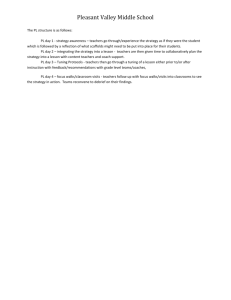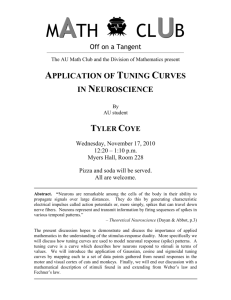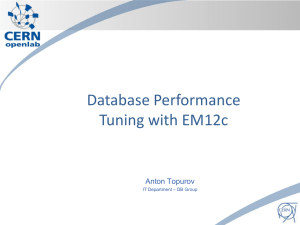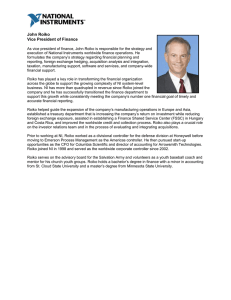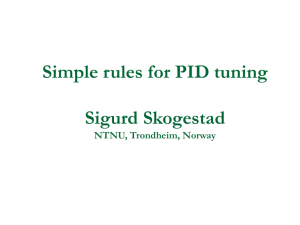Comparing PI controller Performance for Non Linear Process Model
advertisement
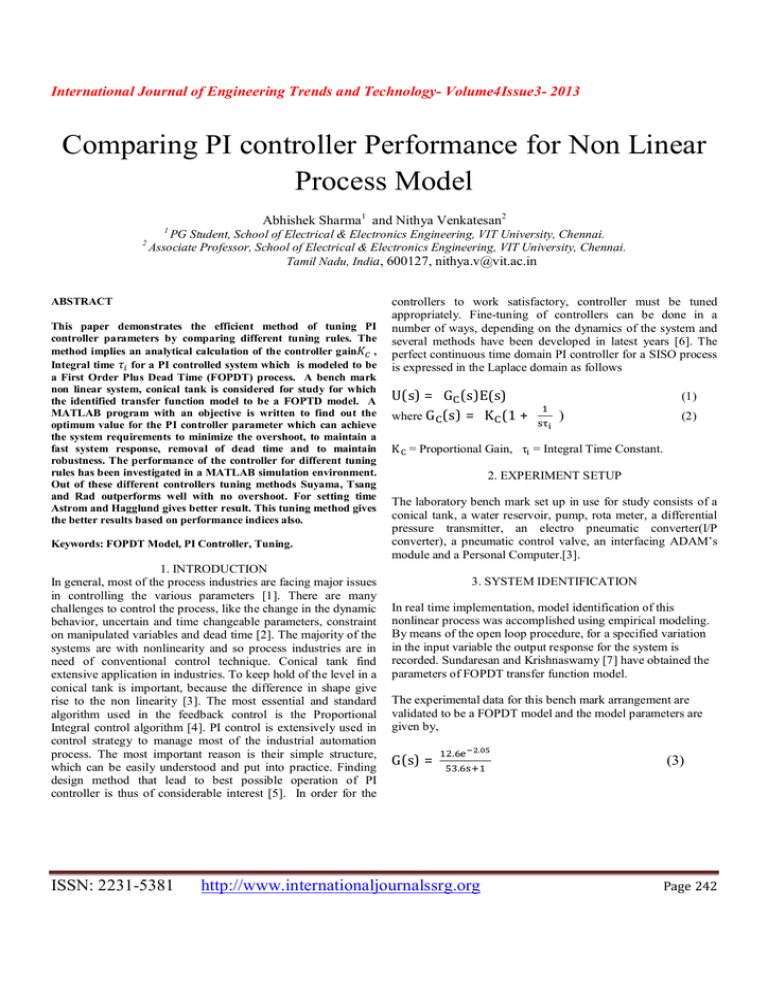
International Journal of Engineering Trends and Technology- Volume4Issue3- 2013 Comparing PI controller Performance for Non Linear Process Model Abhishek Sharma1 and Nithya Venkatesan2 1 2 PG Student, School of Electrical & Electronics Engineering, VIT University, Chennai. Associate Professor, School of Electrical & Electronics Engineering, VIT University, Chennai. Tamil Nadu, India, 600127, nithya.v@vit.ac.in ABSTRACT This paper demonstrates the efficient method of tuning PI controller parameters by comparing different tuning rules. The method implies an analytical calculation of the controller gain , Integral time for a PI controlled system which is modeled to be a First Order Plus Dead Time (FOPDT) process. A bench mark non linear system, conical tank is considered for study for which the identified transfer function model to be a FOPTD model. A MATLAB program with an objective is written to find out the optimum value for the PI controller parameter which can achieve the system requirements to minimize the overshoot, to maintain a fast system response, removal of dead time and to maintain robustness. The performance of the controller for different tuning rules has been investigated in a MATLAB simulation environment. Out of these different controllers tuning methods Suyama, Tsang and Rad outperforms well with no overshoot. For setting time Astrom and Hagglund gives better result. This tuning method gives the better results based on performance indices also. Keywords: FOPDT Model, PI Controller, Tuning. 1. INTRODUCTION In general, most of the process industries are facing major issues in controlling the various parameters [1]. There are many challenges to control the process, like the change in the dynamic behavior, uncertain and time changeable parameters, constraint on manipulated variables and dead time [2]. The majority of the systems are with nonlinearity and so process industries are in need of conventional control technique. Conical tank find extensive application in industries. To keep hold of the level in a conical tank is important, because the difference in shape give rise to the non linearity [3]. The most essential and standard algorithm used in the feedback control is the Proportional Integral control algorithm [4]. PI control is extensively used in control strategy to manage most of the industrial automation process. The most important reason is their simple structure, which can be easily understood and put into practice. Finding design method that lead to best possible operation of PI controller is thus of considerable interest [5]. In order for the ISSN: 2231-5381 controllers to work satisfactory, controller must be tuned appropriately. Fine-tuning of controllers can be done in a number of ways, depending on the dynamics of the system and several methods have been developed in latest years [6]. The perfect continuous time domain PI controller for a SISO process is expressed in the Laplace domain as follows U(s) = G (s)E(s) whereG (s) = K (1 + (1) ) (2) K = Proportional Gain, τ = Integral Time Constant. 2. EXPERIMENT SETUP The laboratory bench mark set up in use for study consists of a conical tank, a water reservoir, pump, rota meter, a differential pressure transmitter, an electro pneumatic converter(I/P converter), a pneumatic control valve, an interfacing ADAM’s module and a Personal Computer.[3]. 3. SYSTEM IDENTIFICATION In real time implementation, model identification of this nonlinear process was accomplished using empirical modeling. By means of the open loop procedure, for a specified variation in the input variable the output response for the system is recorded. Sundaresan and Krishnaswamy [7] have obtained the parameters of FOPDT transfer function model. The experimental data for this bench mark arrangement are validated to be a FOPDT model and the model parameters are given by, G(s) = . . . http://www.internationaljournalssrg.org (3) Page 242 International Journal of Engineering Trends and Technology- Volume4Issue3- 2013 4. DESIGN OF CONTROLLERS Controller tuning methods present the controller parameters in the type of formulae or algorithms [8]. They make sure that the obtained control system would be steady and would meet specified objectives. Also great advances on best possible methods based on stabilizing PI solutions have been achieved [9]. A PI controller is commonly used in engineering control system. PI controller calculation involves two separate constant parameters, Proportional and Integral denoted by P and I [10]. P depends on present error and I on the accumulation of past errors. By tuning these two parameters in PI control algorithm the controller can provide desired action designed for specific process requirement [11]. Different tuning rules used for this benchmark nonlinear system is given in Table 1. Table I: Values for K and τ for different tuning methods Ziegler and Nichols[12] Astrom and Hagglund [13] Sain and Ozgen[14] Cohen and Coon[15] Tsang and Rad[16] Suyama[17] Fruehauf et al.[18] Table II: Different values for Kc and T i for different method K Rule 4.1 PI controller Tuning Rule After using the different tuning rules given in Table 1, the following Table 2 gives the optimum values K and τ used for the study in simulation environment. K 2τm 0.94τ K τ τ τ + 0.1814) τ (1.35 τ + 0.25) 0.809τ K τ ISSN: 2231-5381 0.07438 54.23345 10.25 53.6 1.7387 Ziegler and Nichols Cohen and coon 2.4901 2.82 4.10 8.5353 5. RESULT & DISCUSSIONS . τ τ . . τ ( τ τ τ ) Performances of various controller tuning methods for PI controller are analyzed using MATLAB tested for a given step input. It is found that in Suyama and Tsang and Rad makes the system to settle without overshoot at all. Astrom and Hagglund tuning method settles faster compared to the other tuning rules. Tsang and Rad tuning method have got minimum peak overshoot which is given in Table 3. From Fig 1, it is also clear that Suyama, Tsang and Rad based tuned controller tracks the set point quickly without any oscillations. From Fig 2 , it is observed that Astrom and Hagglund tuning rule settles almost at 0.295 Secs compared to the other tuning rules taken up for study. Table 4 gives the performance indices comparison for a nonlinear system taken for study. τ 1 [0.7236 τ Km τ + 0.2236] 5τ 9K τ 0.8647τ + 0.226τ τ + 0.8647 τ τ 108.07 1.5192 1.152 1.6787 1.4543 5 1 PERFORMANCE ANALYSIS 2τm (0.6939 τ (secs) Astrom and Hagglund Suyama Fruehauf et al. Tsang and Rad Sain and Ozgen By means of different controller tuning methods and the different control parameters K and τ for PI controller, is tested in MATLAB environment for analysis. τ 1.2τ 2τ [ , ] K τ K τ tuning τ + 0.309τ It is evident from the table that similar to time domain analysis Astrom and Hagglund tuning method is very good in terms of ISE, IATE, IAE and MSE values also. From the observed values Cohen and Coon gives next better results on error analysis. 5τm http://www.internationaljournalssrg.org Page 243 International Journal of Engineering Trends and Technology- Volume4Issue3- 2013 6. CONCLUSION Table III: Time Domain Analysis Tuning Method Rise Time (Sec) Peak time (Sec) Peak overshoot % Settling time (Sec) Astrom and Hagglund Suyama 0.0630 0.135 21.2449 0.2610 6.6000 16.50 0.3760 11.1000 Fruehauf et al Tsang and Rad Sain and Ozgen Ziegler & Nichols Cohen & Coon 5.5648 13.21 12.6035 29.9108 5.8300 14.57 0.2987 9.5400 2.8150 5.630 34.6449 20.8310 2.3800 5.780 16.5913 11.5600 2.6000 6.500 8.5419 16.9000 PI Controller with different tuning rules was considered for non linear system. The evaluation is done on the performance analysis based on peak overshoot and settling time is implemented in the software simulation by using different controller tuning methods. It is observed that controller tuning method projected by Astrom and Hagglund is appropriate for non linear process as it has least settling time than other controller tuning methods. This is also validated in the performance indices comparison using different tuning methods. For Suyama, Tsang and Rad tuning demonstrate with zero overshoot and quicker settling time. Table IV: Performance indices Analysis Tuning Method ISE IATE IAE MSE 2.7119 0.4681 6.1810 0.0903 Suyama 5.1897 25.9805 9.8525 0.0927 Fruehauf et al 3.0456 57.9526 7.1401 0.0544 Tsang and Rad 5.2994 23.7331 10.0451 0.0757 Sain and Ozgen 2.9999 35.4492 6.8183 0.0536 Ziegler & Nichols 2.9719 23.4613 6.8625 0.0826 Cohen & Coon 1.7049 19.2928 3.8544 0.0304 Astrom Hagglund and ISSN: 2231-5381 Fig 1: Unit Step response for a conical tank system using different tuning methods for PI controller http://www.internationaljournalssrg.org Page 244 International Journal of Engineering Trends and Technology- Volume4Issue3- 2013 Fig 2: Unit Step response for a conical tank system using Astrom and Hagglund methods for PI controller REFERENCES [9]. Panagopoulos H., Astrom K.J.,Hagglund T. ,“ Design of PID controllers based on constrained optimization, ”IEEE Proc., Control Theory Appl., 2002 ,Vol.149,NO.1-P.32-40. [10] B.Kristiansson, B.Lennartsson, Robust and optimal tuning of PI and PID controllers.IEEProceedings- Control Theory and Applications 2002,149, (1),pp 17 -25. [11] M. Zhuang, D.Atherton, ‘Tuning PID controllers with integral performance criterion in control’ Heriot-watt university,Edinburgh,UK,1991. [12] J G Ziegler and N. B. Nichols, “Optimum Settings for Automatic Controllers”Trans.ASME,1942,Vol 64 pp.759-768. [13] K.J. Astrom, T. Hagglund, “Revisiting the ZieglerNichols step response method for PID control”, Journal of Process Control 2004.,14, pp 635-650 [14] SAIN,S.G and OZGEN,C‘Identification and Tuning of Process with large dead time’, Control and Computers,1992,20(3),pp 73 -78. [15] Cohen,G.H., Coon,G.A. Theoretical consideration of retarded control, Trans . ASME ,1953 ,75,pp 827-834. [16] TSANG,K.M. and RAD,A.B ‘A new approach to autotuning of PID controllers, International Journal of System Science,1995,26,(3),pp.639-658. [17]Suyama,K ‘ A simple design method for sampled- data PID control systems with adequate step responses’, Proceedings of the international conference on Industrial Electronics, Control, Instrumentation and automation,1992,pp.1117-1122. [18] FRUEHAUF,P.S.,CHIEN,I.-L and LAURITSEN,M.D.: ‘Simplified IMC-PID tuning rules’,Proceedings of the ISA 1993 Advances in Instrumentation and control Conference,pp.17451766. [1] C.A Smith, A.B.Corripio Principles and Practice of Automatic Process Control,Wiley, 1997 [2] T.E Marlin, Process Control McGraw-Hill, 2000. [3] Nithya Venkatesan, N .Ananatharaman, “Controller design based on Model Predictive Control for a nonlinear process”, IEEE Proc of 8th International symposium on Mechatronics and its Applications’ (ISMA12), Sharjah, UAE, 2012,p 1 – 6. [4] R. Ciancone, T.Marlin, Tune controllers to meet plant objectives,control,1992,p 50 – 57. [5] P.Cominos and N.Munro, “PID controllers: Recent tuning methods and design to specification, ”IEE Proc. D,Control Theory and Applications, 2002,Vol.149,No. 1,pp.46-53. [6]SHINSKEY,F.G‘ Process ControlSystemsapplication,Design and Tuning’,McGraw-Hill Inc. 1988. [7] Sundaresan,K.R.;Krishnaswamy,R.R.,Estimation of time delay,Time constant parameters in Time, Frequency and LaplaceDomains, Can.J.Chem.Eng,,1978, 56,.257. [8] G.K. McMillan, Tuning and control Loop Performance, instrument Society of America, 2 nd edition , 1990. ISSN: 2231-5381 http://www.internationaljournalssrg.org Page 245
